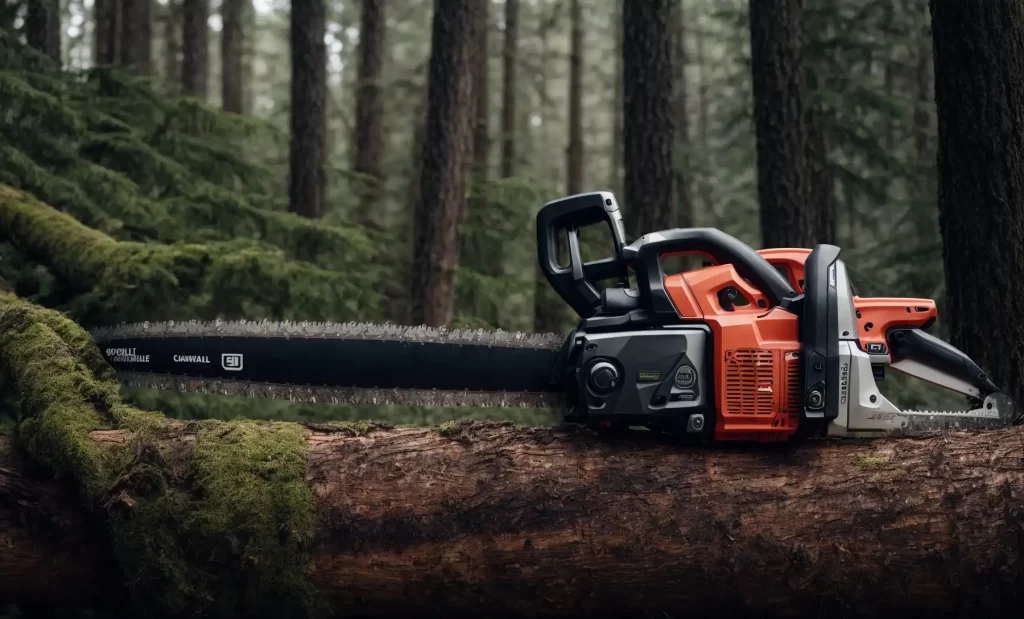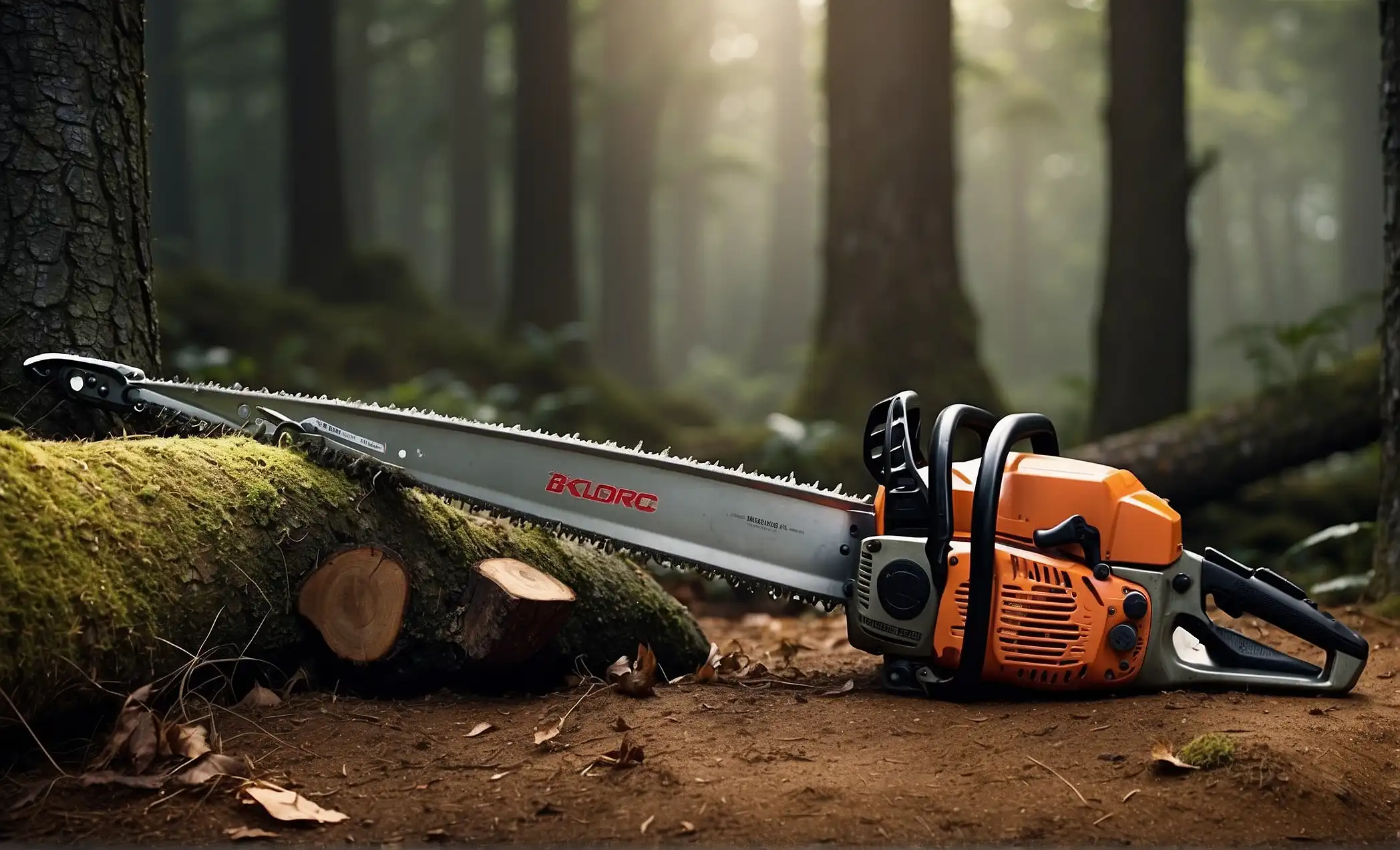A pole saw is for reaching high branches with its long handle, while a chainsaw is more powerful for cutting through thick wood at close range.
Deciding between a pole saw and a chainsaw involves understanding the scope of your outdoor tasks. Pole saws extend your reach, enabling safe trimming of high branches without the need for ladders or climbing. They are light and maneuverable for overhead work, making them ideal for keeping your trees well-groomed and your feet firmly planted on the ground.
Chainsaws, on the other hand, are powerful tools that cut through thick trunks and branches with ease. They are indispensable for cutting down trees, slicing firewood, and tackling large-scale yard cleanups. Knowing which tool to use comes down to the job’s specific requirements – precision pruning versus robust cutting power. Selecting the right equipment ensures efficiency, safety, and the health of your trees.
About Tree Cutting Tools
Tree cutting tools are essential for proper garden maintenance. They help keep trees in shape, remove dead branches, and cut down unwanted trees. Two popular tools are pole saws and chainsaws. Understanding their uses and differences is key. This guide will dive into the specifics of these tools, providing insights on when and how to use each for optimal tree care.
Overview of Pole Saws

A pole saw, or pole pruner, is a powerful garden tool. It combines a small chainsaw on a long pole. It’s designed for pruning and trimming branches. This tool allows you to reach high limbs without a ladder. Cutting can be done from the ground, which is safer and more convenient. Below are key features to consider:
- Extended Reach: Typically extends 6 to 20 feet.
- Power Source: Available in manual, electric, and gas models.
- Safety: Reduces the need to climb, minimising fall risks.
- Usability: Lightweight and easy to manoeuver.
Overview of Chainsaws

A chainsaw is a portable, mechanical saw. It’s powered by electricity, battery, or gas. This tool excels at cutting through wood quickly. Great for felling trees, cutting firewood, and other heavy-duty tasks. Chainsaws vary in size and power, tailored to different tasks. The following points highlight the chainsaw’s characteristics:
| Power | Size and Weight | Type |
|---|---|---|
| High Torque | Varies, some can be heavy | Electric, Battery, Gas |
| Fast Cutting | Portable | Chain Blade Length |
| Heavy-duty | Requires strength to handle | Recommended for large tasks |
Always wear safety gear when using a chainsaw. This includes gloves, goggles, and ear protection. Proper operation is crucial to avoid accidents. When deciding between a pole saw vs chainsaw, consider the height of the branches you need to cut and the power required for the job.
Design and Mechanics: Pole Saw Vs Chainsaw
Understanding the design and mechanics behind pole saws and chainsaws is crucial. Each tool caters to different needs. They have unique features that make them suitable for specific tasks. Let’s delve into the design elements of both.
Design Features of Pole Saws
Pole saws blend reach and cutting ability. Check out their design traits:
- Long Shaft: Helps trim high branches without a ladder.
- Lightweight Build: Ensures easy lifting and maneuverability.
- Adjustable Length: Some models extend to different lengths.
- Powered Head: A mini chainsaw or cutting tool sits at the shaft’s end.
- Power Source: They can be electric, battery, or gas-operated.
Their design suits maintaining trees and shrubs without strain.
Design Features of Chainsaws
Chainsaws are robust and powerful. Below are their design aspects:
- Sturdy Blades: They house chains with sharp teeth for cutting.
- Motor Placement: Located near the user for balance and control.
- Heavy-Duty Construction: Built to handle tough cuts and resist wear.
- Size and Weight: Vary based on model, for diverse cutting jobs.
- Hand Guards: Essential for user safety during operation.
Chainsaw design tackles heavy-duty cutting, like felling trees and slicing thick logs.
Functionality and Use Cases: Pole Saw Vs Chainsaw
Understanding the strengths of pole saws and chainsaws is key to their optimal utilization. Each tool has its unique functionality and fits perfectly for specific tasks in the realm of cutting and tree maintenance. A deep dive into their ideal use cases reveals where each tool shines.
Ideal Situations For Using a Pole Saw
Pole saws excel in reaching heights without the need for a ladder. With their extended reach, they offer safety and convenience:
- Trimming branches overhead without climbing.
- Clearing brush around fences and in gardens.
- Pruning in tight spaces where larger saws can’t fit.
- Maintaining fruit trees to encourage better yields.
Their lightweight design and maneuverability make pole saws a must-have for precision tasks at height.
Ideal Situations For Using a Chainsaw
Chainsaws, on the other hand, are powerful tools designed for heavy-duty cutting tasks:
- Felling medium to large trees efficiently.
- Chopping firewood from logs.
- Managing storm damage where thick limbs or trees need removal.
- Engaging in construction projects requiring significant woodcutting.
With their robust capabilities, chainsaws handle the tough jobs that pole saws cannot tackle.
Safety and Handling: Pole Saw Vs Chainsaw
Understanding the right safety measures for pole saws and chainsaws ensures confidence during their use. Both tools are powerful and demand respect to operate. This section delves into the specific safety practices required for handling each tool effectively.
Safety Precautions With Pole Saws
- Always wear a helmet, gloves, and safety glasses.
- Keep a firm grip and maintain a balanced stance.
- Ensure others stay at least 50 feet away.
- Inspect the saw before use for any damage.
- Use with feet firmly on the ground; never on a ladder.
- Avoid using in wet conditions to prevent slips.
Safety Precautions With Chainsaws
- Start by wearing protective gear: chaps, gloves, and boots.
- Check the chain’s tension and sharpness before every use.
- Engage the chain brake when starting the chainsaw.
- Keep both hands on the handles and stand to the side.
- Do not cut with the tip to avoid kickback.
- Operate the chainsaw only if you’re well-rested and alert.
The goal is to create a safe work environment, regardless of which tool is in hand. Handling with care and following these tips cuts down risks remarkably.
Maintenance and Longevity: Pole Saw Vs Chainsaw
Maintenance and longevity are crucial for keeping your cutting tools in prime condition. Whether working above ground with a pole saw or cutting at the base with a chainsaw, understanding the proper care regime ensures safety, efficiency, and a longer life for each tool. Let’s delve into how best to maintain these powerful devices.
Maintaining Your Pole Saw
- Clean the saw after each use to remove debris and sap.
- Inspect the pole and tighten connections regularly.
- Check the chain tension before every use for optimal cutting.
- Lubricate moving parts to prevent wear and tear.
- Store in a dry place to avoid rust and corrosion.
Maintaining Your Chainsaw
| Task | Frequency |
|---|---|
| Clean the air filter | After every use |
| Sharpen the chain | When it becomes dull |
| Inspect for damaged parts | Regular intervals |
| Lubricate the engine | According to manufacturer’s guide |
| Store properly | After each project |
Remember, proper chainsaw maintenance enhances cutting performance and extends the machine’s life. Regular inspection for any wear or damage is crucial. Use clean, quality oil for the engine and always keep the chain sharp. Proper storage away from moisture minimizes the risk of rust and corrosion.
Making the Right Choice
Choosing a pole saw or chainsaw is a big decision. Both tools have their strengths. Your choice depends on the job at hand.
Factors To Consider When Choosing Between A Pole Saw And Chainsaw
Think about what you need before picking your tool.
- Height and Accessibility: Is the branch high up or hard to reach? Pick a pole saw.
- Power: Need to cut thick wood? A chainsaw has more strength.
- Portability: A pole saw is lighter. Easy to move around.
- Safety: Chainsaws need more care. Use safely.
- Job Frequency: Often trimming trees? Get a pole saw. For occasional big cuts, a chainsaw works.
Recommendations Based on Use Case Scenarios
| Task | Pole Saw | Chainsaw |
|---|---|---|
| Trimming Leaves/Small Branches | Yes | No |
| Felling Trees | No | Yes |
| Cutting High Branches | Yes | No |
| Sawing Thick Logs | No | Yes |
| Maintenance Jobs | Maybe | Maybe |
- For rooftop work, choose a pole saw. It’s safe and easy to handle.
- For ground-level heavy cutting, use a chainsaw. It’s powerful and fast.
- Having both may be best for frequent garden jobs.
Know more: Stihl Farm Boss Vs Wood Boss
FAQs On Pole Saw Vs Chainsaw
Should I Get Pole Saw or Chainsaw?
Choose a pole saw for trimming branches high up and maintaining trees. Opt for a chainsaw for cutting down trees or slicing through thick logs on the ground. Your specific task dictates the best tool.
What Do You Use Pole Saw For?
A pole saw is a tool used for trimming branches and limbs from trees without the need for a ladder, to maintain tree health and yard safety.
How Big of a Branch Can a Pole Saw Cut?
A pole saw can typically cut branches up to 8 inches in diameter, depending on the model and blade length. Always check the saw’s specifications for maximum cutting capacity.
What Is the Difference Between a Pole Saw and a Pole Pruner?
A pole saw features a small chainsaw on a long pole for cutting branches, while a pole pruner has a scissor-like mechanism for snipping thinner stems.
Conclusion
Deciding between a pole saw and a chainsaw hinges on your specific needs. Pole saws offer extended reach with less power, ideal for pruning. In contrast, chainsaws deliver robust cutting for larger jobs. Assess your tasks carefully to make the right tool choice for safety and efficiency in your yard work.
Eager for more chainsaw savvy? Chainsaw Hive’s Comparisons category is your personal library of all things chainsaw.
